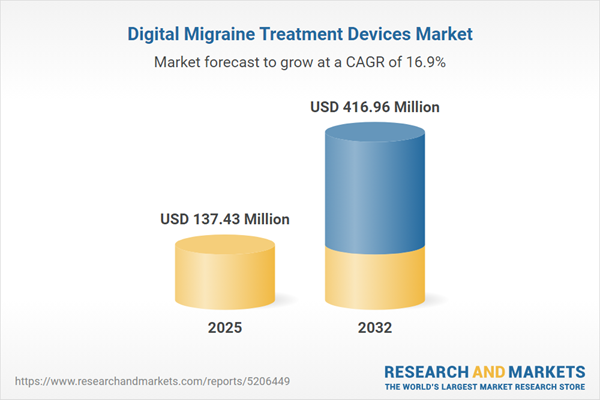Speak directly to the analyst to clarify any post sales queries you may have.
The digital migraine treatment devices market is gaining momentum as healthcare organizations proactively adopt advanced tools to deliver tailored and efficient care. This overview provides executive leaders with actionable insights to align digital migraine care initiatives with broader organizational strategies.
Market Snapshot: Digital Migraine Treatment Devices Market
In 2024, the digital migraine treatment devices market reached USD 119.71 million and is projected to grow to USD 137.43 million by 2025, with further expansion to USD 416.96 million by 2032. This upward trend is propelled by increasing adoption of neuromodulation and data-driven therapy solutions. Widespread acceptance among clinicians and patients is supported by advances that improve integration across clinical, ambulatory, and home care environments. Manufacturers are prioritizing seamless workflow integration, which accelerates device adoption and helps providers set new benchmarks for care quality and operational performance.
Scope & Segmentation
- Device Types: Includes handheld, implantable, and wearable migraine treatment devices. These formats offer effective options for immediate intervention as well as long-term management, enabling flexible deployment in settings such as hospitals, ambulatory centers, specialty clinics, and home healthcare.
- Technology: Features remote electrical neuromodulation, transcranial magnetic stimulation, transcutaneous electrical nerve stimulation, and vagus nerve stimulation. Emphasis on non-invasive and minimally invasive solutions delivers patient-friendly experiences and facilitates quick adoption across institutional and home settings.
- End-Users: Serves homecare providers, hospitals, migraine centers, and ambulatory clinics. Segment variety supports rapid symptom relief, chronic disease management, and integration into multidisciplinary care protocols for diverse patient populations.
- Distribution Channels: Leverages clinical supply chain networks alongside digital retail platforms to increase device access for both healthcare organizations and individuals. These delivery frameworks support reliable distribution and maintain availability across a range of facilities.
- Regions Covered: Addresses the Americas, Europe, Asia-Pacific, Middle East, and Africa. Regional nuances in regulatory conditions and reimbursement frameworks require adaptable strategies to ensure compliance and efficient market entry.
- Leading Companies: Major market players include CEFALY Technology, Chordate Medical Holding AB, Cirrus Healthcare Products, Dr Reddy’s Laboratories, electroCore, eNeura, Hi-Dow, LivaNova, Neurolief, Nocira, Salvia BioElectronics, ShiraTronics, Soterix Medical, Theranica Bio-Electronics, Tivic Health Systems, tVNS technologies, and WELT Corp. Competitive positioning is influenced by clinical validation, continuous product innovation, and the advancement of operational standards.
Key Takeaways for Decision-Makers
- Integrated neuromodulation platforms support streamlined clinical workflows and facilitate coordination across multidisciplinary care teams, improving overall treatment accessibility.
- Some devices leverage artificial intelligence, enhancing real-time patient monitoring and strengthening adherence in both face-to-face and virtual care models.
- Integration with electronic health record systems fosters collaborative and timely clinical decision-making, especially for patients with complex migraine presentations.
- Proactive inventory and supply chain strategies reinforce operational stability, helping to safeguard consistent device availability regardless of shifts in demand or logistics.
- Responsive alignment with evolving regulatory and payment environments aids organizations in mitigating commercial risks while entering or expanding within regional markets.
- Continuous collection of clinical data and outcome reporting deepens stakeholder trust and ensures reliable evaluations of new migraine management technologies.
Tariff Impact on Supply Chain and Manufacturing
Forthcoming US tariff changes in 2025 will require manufacturers in the digital migraine treatment devices market to review and optimize supply chain and production operations. Strengthening supplier networks, pursuing vertical integration, and updating inventory protocols are key strategies for adapting to tariff-related cost pressures. Proactive engagement with regulatory stakeholders can create opportunities for tariff relief and support the continued flow of devices into healthcare systems, minimizing potential disruptions caused by shifting trade policies.
Methodology & Data Sources
This report draws upon current regulatory standards, recent clinical research, and extensive feedback from device trial stakeholders. Insights from experts in neurology, biomedical engineering, and reimbursement policy, as well as patent analysis and professional interviews, ensure that findings are both practical and robust.
Why This Report Matters
- Delivers actionable frameworks that help organizations differentiate products and shape successful entry strategies in the digital migraine treatment sector.
- Provides healthcare executives and investors with targeted segmentation and competitor profiling to support precise opportunity assessment and benchmarking.
- Enables leaders to navigate operational integration and technology challenges with recommendations informed by real-world clinical and commercial outcomes.
Conclusion
This analysis offers clear direction for optimizing digital migraine management strategies, supporting executives in steering effective and sustainable enhancements within healthcare organizations.
Additional Product Information:
- Purchase of this report includes 1 year online access with quarterly updates.
- This report can be updated on request. Please contact our Customer Experience team using the Ask a Question widget on our website.
Table of Contents
3. Executive Summary
4. Market Overview
7. Cumulative Impact of Artificial Intelligence 2025
List of Figures
Companies Mentioned
The companies profiled in this Digital Migraine Treatment Devices market report include:- CEFALY Technology
- Chordate Medical Holding AB
- Cirrus Healthcare Products LLC
- Dr Reddy's Laboratories Ltd.
- electroCore, Inc.
- eNeura Inc.
- Hi-Dow International Inc.
- LivaNova PLC
- Neurolief Ltd.
- Nocira, LLC
- Salvia BioElectronics B.V.
- ShiraTronics, Inc.
- Soterix Medical Inc.
- Theranica Bio-Electronics Ltd.
- Tivic Health Systems, Inc.
- tVNS technologies GmbH
- WELT Corp.
Table Information
| Report Attribute | Details |
|---|---|
| No. of Pages | 183 |
| Published | November 2025 |
| Forecast Period | 2025 - 2032 |
| Estimated Market Value ( USD | $ 137.43 Million |
| Forecasted Market Value ( USD | $ 416.96 Million |
| Compound Annual Growth Rate | 16.8% |
| Regions Covered | Global |
| No. of Companies Mentioned | 18 |









